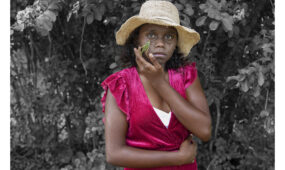Mural design revealed for new-look Her Majesty's Theatre
InReview
A huge mural featuring South Australian native plants and flowers will grace the side of the newly completed Her Majesty’s Theatre when it reopens in 2020 after a major $66 million redevelopment.

South Australian artist Yvonne East has beaten a field of artists to win the right to paint her 130sqm design featuring species including beaked hakea, blue gum and purple cockatoo on the back wall of the theatre, visible via Rowlands Place.
When it came to the design, East’s brief was to create something that evokes a sense of calm and curiosity in passersby.
“Inspired by Her Majesty’s Theatre and the rich performing arts history of Adelaide, the design is a bouquet of South Australian native flowers, to honour and applaud the grand dame at the end of each performance,” says East, who was a finalist in last year’s Archibald Prize.
“South Australian native plants and flowers have been selected, in a variety of blues and greens, to provide detail and visual interest yet also to integrate soothing colours.

Photo: Yvonne East’s mural design.
“It was hard to design, in a way, because the building doesn’t exist yet, so the wall isn’t actually there.”
The work also includes a “note of devotion” at the bottom that reads, “From Adelaide”.
East, who grew up in South Australia, including Wistow and Loxton, is now based in Sydney, but has fond memories of going to Her Majesty’s over the years.
“I’ve always loved the Maj,” she says. “I actually had a wonderful conversation with [actor] Ian McKellen there when he was in town to perform Waiting for Godot.
“I feel honoured to be a part of this next chapter of Her Majesty’s Theatre. It’s a dream come true for a South Aussie girl.”
Adelaide Festival Centre director of programming Liz Hawkins says a commissioning tender process was held where artists submitted an expression of interest in the theatre mural.
“We then shortlisted to three and asked them for a design,” Hawkins says. “A selection panel involving staff from Adelaide Festival Centre and the Performing Arts Collection’s senior curator made the final selection and chose Yvonne’s piece.”
The $66.2 million Her Majesty’s redevelopment is more than halfway through and will see the 970-seat capacity expanded to a 1472-seat auditorium over three levels.
Hawkins says the upgraded facilities will allow more musical theatre productions to be staged in Adelaide.
“Many musicals did miss Adelaide because we simply couldn’t accommodate them due to the competing pressure on the Festival Theatre,” she says.
The revamp will also include expanded foyers and a spacious backstage area.
Most of the original Edwardian features were removed from the historic theatre during renovations in the 1960s and ’70s, and the only original aspects of the building were the front facade on Grote Street, the western wall and the Pitt Street wall.
Hawkins says the massive redevelopment project has been challenging for construction company Hansen Yuncken, particularly the preservation and protection of the heritage walls. More than 54 tonnes of steel supports were needed to keep the walls in place during construction.
“We’re pleased that the builders have successfully maintained the original Tivoli Theatre frontage,” Hawkins says.
“Cox Architects are bringing back some of the original Edwardian features into the new design, including interiors inspired by the original Edwardian panelling. The foyer staircases have a similar curve to the originals and we have of course kept the original signature wall, which was removed brick by brick and will be reconstructed backstage for a whole new generation of artists to sign.”
Salvaging material through the demolition process has also been a priority, with timber from the original stage floor used in some of the new joinery.
“We also found an original theatrical program from 1917 underneath the floorboards and seating, and all pieces of original molding and cornice work, and everything we have found has been catalogued and has become part of the Performing Arts Collection,” says Hawkins.
Elements of the building currently under construction include the new auditorium proscenium arch, the stage, orchestra pit and seat tiers, and the new foyer and bar building in the former 62 Grote Street location next door.
“Next, work inside will include the full fitout and installation of the beautiful design elements, installation of the new technical equipment, reinstating the seating, reinstating the signature wall and installing a bespoke loading dock on Pitt Street. It’s an immensely complex but exciting project,” says Hawkins.
“We anticipate the building will be sealed and fully covered before the end of this year.”
The AFC has also recently launched its “Buy a Seat” campaign where members of the public can buy a chair at Her Majesty’s, with their name plaque placed on the back.
The entire Her Majesty’s project is expected to be completed in by mid-2020 and there will be announcements in coming months about a series of opening events.
“We plan to have at least six months of celebratory events to make sure the whole community can take part,” Hawkins says, adding that being involved in the Her Maj project has been a career highlight.

Get InReview in your inbox – free each Saturday. Local arts and culture – covered.
Thanks for signing up to the InReview newsletter.
“This is the last of the original Tivoli Theatres in the country and it is a tremendous responsibility to ensure that the history is preserved but that it is also a high-quality and technically state-of-the art theatre.
“I can’t wait for this theatre to reopen because that sense of history, which patrons and artists alike felt when they walked through the door, is still there.”
Support local arts journalism
Your support will help us continue the important work of InReview in publishing free professional journalism that celebrates, interrogates and amplifies arts and culture in South Australia.
Donate Here





